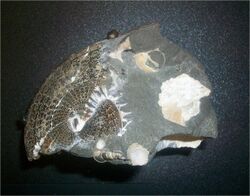Biology:Sphenodiscus
| Sphenodiscus | |
|---|---|

| |
| Sphenodiscus lenticularis | |
| Scientific classification | |
| Domain: | Eukaryota |
| Kingdom: | Animalia |
| Phylum: | Mollusca |
| Class: | Cephalopoda |
| Subclass: | †Ammonoidea |
| Order: | †Ammonitida |
| Family: | †Sphenodiscidae |
| Genus: | †Sphenodiscus Meek, 1871 |
| Species | |
| |
Sphenodiscus is an extinct genus of acanthoceratacean ammonite. The genus has been found from many continents and is thought to have had a large global distribution during the Maastrichtian stage of the Late Cretaceous. It was one of the last ammonoids to have evolved before the entire subclass became extinct during the Paleocene, which was directly after the Cretaceous–Paleogene extinction event.
Distribution

Fossils have been found throughout North America from localities in South Carolina,[1] North Carolina,[2] South Dakota,[3] Maryland,[4] New Jersey[5] and Mexico.[6] There is also evidence of the genus being present from the island of Trinidad, although the material found from here cannot be classified at the species level.[7] Common species found in North America include S. lobatus, S. lenticularis, and S. pleurisepta. New species have been found from localities outside of North America such as S. binkhorsti from the Maastricht Formation in the Netherlands, S. siva from the Valudavur Formation in India and S. brasiliensis from the beds along the banks of the Rio Gramame in Brazil .[8][9][10] Many specimens of S. lobatus have also been found from the Nkporo Shale in Nigeria.
Description
The shell of Sphenodiscus was streamlined and lateromedially compressed with overlapping whorls and a small umbilicus. The ventral edge of the shell tends to be sharply angled. The outer surface is generally smooth in fossil specimens, although certain species at different stages of ontogenic development may possess many small tubercles along their surfaces.[11] Sphenodiscus had a complex suture pattern with many small branching lobes and saddles.
References
- ↑ Allmon, W. D.; Knight, J. L. (1993). "Paleoecological significance of a turritelline gastropod-dominated assemblage in the Cretaceous of South Carolina". Journal of Paleontology 67 (3): 355–360. doi:10.1017/S0022336000036830.
- ↑ "Online Collections | North Carolina Museum of Natural Sciences". http://collections.naturalsciences.org/resultsInvertPaleo.aspx.
- ↑ Turekian, K. K.; Armstrong, R. L. (1961). "Chemical and mineralogical composition of fossil molluscan shells from the Fox Hills Formation, South Dakota". GSA Bulletin 72 (12): 1817–1828. doi:10.1130/0016-7606(1961)72[1817:CAMCOF2.0.CO;2]. Bibcode: 1961GSAB...72.1817T.
- ↑ Landman, N. H.; Johnson, R. O.; Edwards, L. E. (2004). "Cephalopods from the Cretaceous/Tertiary boundary interval on the Atlantic Coastal Plain, with a description of the highest ammonite zones in North America. Part 1, Maryland and North Carolina". American Museum Novitates (3454): 1. doi:10.1206/0003-0082(2004)454<0001:CFTTBI>2.0.CO;2. https://zenodo.org/record/5382650.
- ↑ Kennedy, W. J.; Cobban, W. A. (1996). "Maastrichtian Ammonites from the Hornerstown Formation in New Jersey". Journal of Paleontology 70 (5): 798–804. doi:10.1017/S0022336000023842.
- ↑ Böse, E. (1927). "Cretaceous ammonites from Texas and northern Mexico". University of Texas Bulletin 2748 (2): 143–357.
- ↑ Rutsch, R. F. (1939). "Upper Cretaceous Fossils from Trinidad, B. W. I". Journal of Paleontology 13 (5): 521–523.
- ↑ Kennedy, W. J. (1986). "The Campanian-Maastrichtian ammonite sequence in the environs of Maastricht (Limburg, the Netherlands), Limburg and Liège provinces (Belgium)". Newsletters on Stratigraphy 16 (3): 149–168. doi:10.1127/nos/16/1986/149. http://www.schweizerbart.de/papers/nos/detail/16/55917.
- ↑ Hancock, J. M. (1967). "Some Cretaceous-Tertiary marine faunal changes". Geological Society, London, Special Publications 2 (1): 91–104. doi:10.1144/GSL.SP.1967.002.01.10. Bibcode: 1967GSLSP...2...91H.
- ↑ Maury, C. J. (1930). "O Cretaceo da Parahyba do Norte". Serviço Geologico e Mineralogico do Brasil Monographia 8: 1–305.
- ↑ Bandel, K.; Landman, N. H.; Waage, K. M. (1982). "Micro-Ornament on Early Whorls of Mesozoic Ammonites: Implications for Early Ontogeny". Journal of Paleontology 56 (2): 386–391.
External links
Wikidata ☰ Q7576640 entry
 |


